- Getting around Lijiang. Dont stay in the Old Towns more than 2 days, there is nothing to do. KRISS Oct 9, 2013 05:46
- 2013 Beijing Temple Fair BENNYLAU Feb 26, 2013 03:29
- Malaysian traveling from KUL - LAX vis Shanghai PVG ZATI_DY Jan 3, 2013 20:15
Yellow Mountain II: From Sunrise to Sunset
- Views: 9444
- |Vote: 2 0
- |Add to Favorites
- |Recommend to Friends
Race to Brightness Top
It’s before 5am, New Year’ Eve 2007 and I shouldn’t be awake, but I am. It’s been a night of snatched pieces of sleep in between long, cold wakeful hours. My small flask that has doubled as a life-saving hot-water bottle is now beginning to get a film of ice on it. Nothing else for it, I get up.
There’s little to do. I’m already almost fully dressed and still freezing. I get my stuff together and head out to the small store where I pick up a couple of tea eggs for breakfast.
Breakfast on the move as it happens as I begin the long walk to Brightness Top. I had already decided this would be where I would watch the last sunrise of 2007. The 1840m high peak is home to Yellow Mountain’s meteorological observatory and reputed to offer superb views to the East.
In the dark though, it’s hard to imagine this is even morning, and I’m quickly back into the familiar boot on step routine. I make slow progress in the cold, thick gloom barely able to see beyond the sides of the steps, and following the occasional signs lit by my mobile phone.
A Chinese couple, that might be ghosts so little can I see of them, warn me I’ll never make it in time.
[image: early morning looking east]
The Last Sunrise of 2007
I do make it on time. But it’s with a growing sense of disappointment that I realise the lateness of the hour is going to mean I still don’t get to see the sunrise. The small vantage points are already completely packed with cameras and the backs of dozens of people who got here earlier.
It’s 6.50am and there’s less than 10 minutes to go. Amazingly it’s almost light even though the sun hasn’t appeared. I resign myself to seeing a second-hand sunrise, and try to convince myself it doesn’t matter if I don’t see that very moment where it rises from the clouds.
Perhaps it is another ghost who points the way, but in desperation I follow a figure who seems in a huge hurry. Up the back of the meteorological station, up a rock face that is frighteningly steep (and I only make it because of his hand helping me), over a fence and suddenly I’m on top of the station with the antennae and an unbeatable view.
Far above the lookout points crowded with people, and with a tiny group of officials who don’t notice how I just arrived, I see the last sunrise of the year.
[image: breathtaking sunrise]
Heading West over the Summit
It’s a long and sometimes confusing walk over to the start of the West Grand Canyon route. It’s also busy. It may be below zero and not yet 8am, but tour groups and travellers are already on the move.
The summit is much hillier than I expect and any walking involves as many steps up as down. The popular routes in between the main hotels are a little flatter and weave first through pockets of pine trees and then through groves of deciduous trees that are nothing but twiggy jungles. There’s the slightest covering of snow on the ground as though someone has wandered past sifting flour.
The path soon takes a more exciting turn as it nears the canyon, emerging from the forests to skirt the cliff edges. The views are correspondingly impressive, out over the rocky ridges of mountains that don’t stop until your eyes meet the horizon.
[image: pines, cliffs & distant mountains]
The West Grand Canyon Route is Closed
The piercing cold clarity of winter brings with it impossibly blue skies, and resting on the shoulders of the mountains are breaths of faint pink cloud.
In the foreground, the tall pyramid-shaped pine trees that almost resemble pagodas, are thrown into silhouette by the climbing sun. Waterfalls are frozen over the faces of rocks in smooth sheets of ice, or caught in the sharp points of icicles and their occasional drips.
Years worth of friends and couples in love have brought their padlocks to the top of Yellow Mountain. The safety chains and rails are hidden beneath thousands of them.
To my huge disappointment, the path leads on only another few hundred enticingly beautiful metres before it ends in a large, locked gate. A security officer keeps watch and mutters that it won’t re-open until Spring.
So I must backtrack along the cliff edges, through the tunnels that squeeze between the rocks, up and down the narrow flights of steps. I am overwhelmed by this tiny taster of the West Grand Canyon Route and am left with nothing but my imagination to conjure up how amazing the full route might be.
[image: padlock of love]
Reservoirs and Flying Rocks
Fortunately the summit area is big and beautiful enough to keep anyone occupied for at least a day of walking and exploring. Photographers especially love it here, with the combinations of pure light, spectacular scenery and mountainous vistas.
I walk a considerable way, taking a route that first leads me around the Xihai Reservoir [西海水库] before passing the intriguingly named Flying Over Rock [飞来石].
The reservoir is nestled in a large valley surrounded by pine trees and hills. The water is a rich turquoise and with the sun streaming down through the trees it seems remarkable that I am in fact on top of a mountain.
Flying Over Rock is actually a 12m high, 544 tonne piece of rock that is balanced on a very small ledge. A flight of steps leads to the ledge and less than 10 people can fit on it at any one time. It’s a tight space edged with terrifying drops and thankfully guarded with man-made safety rails.
Typical of Yellow Mountain’s improbable and extravagant natural beauty, Flying Over Rock is a mini pilgrimage site for summit walkers to flock to, have their photos taken and move on. I naturally follow suit!
[image: flying over rock]
The Northern Route via the Taiping Cable Car
I didn’t even know there was a Northern Route at Yellow Mountain, but when I arrive by chance at Red Cloud Station [丹霞站], I decide to check it out. I don’t have time to walk down and take the cable car back, so I have no other choice but to rest my legs and go for the easy option.
The Taiping Cable Car [太平索道] runs infrequently in winter, once an hour, and accommodates a large amount of people. Therefore I’m ushered into a waiting room that just happens to be furnished in unexpected splendour with an air-conditioning machine set to 30ºC. It is the warmest, most comfortable episode in my whole journey.
Half an hour later and I’m more than a little reluctant to make my way, with 20 other passengers into the cable car. The 20 minute ride is not for those with a fear of heights as we swing out and down over dizzying drops. The mountain underneath us is a mixture of vertical cliffs and gushing waterfalls. In the distance, the towns are ridiculously tiny, and look like model villages scattered on the land.
[image: looking down on the cable car coming up]
An Old Monastery and the Emerald Pool
The bottom of the Northern Route offers little in the way of exploration and unless you’re going that way, or particularly enjoy cable car rides, it doesn’t warrant the 100RMB+ to get there. Nevertheless it makes for a quiet spot to enjoy a late lunch and admire the crystal clear waters of the Emerald Pool.
There’s an old monastery that is picturesque but appears to be in a state of quiet collapse. A man is busy farming the land in front of it, but otherwise there isn’t another person. I follow the rushing sound of the water down through the familiar land-based terrain of bamboo groves whose giant green stems are in stark contrast with the bare mountain colours.
The waters in the stream are gleaming and I can see the rocks at the bottom as though there is nothing but a pane of blue-green glass between them and my eyes. Giant boulders crowd and direct the stream from tumbling cascade to deep pool and ever downwards. Many of the rocks are carved with poems and inscriptions and it is near one decorated with a Buddhist figure that I stop for something to eat.
It’s an atmospheric spot, here, where the water falls from a small crush of rocks into a pool. Overhead, the feathery fronds of giant bamboos curve like cathedral arches and the bulky peaks of Yellow Mountain stand firmly against the sky.
[image: bamboo framed yellow mountain]
The Monkey Watching the Sea
Returning to the top of the mountain I have a couple of hours before the sunset and take another route that will lead me to Lion Peak [狮子峰] calling in on the Monkey Watching the Sea [猴子观海] along the way.
I’m fascinated by the little figure of rock that is depicted on the map as a monkey and this is enough to get my legs back into gear to do some more climbing. I don’t expect it but the route is almost entirely uphill through an area packed with pine trees. Beneath the pines are the short fat leaves of pygmy bamboos and the ground is crunchy with fallen needles.
Even more unexpected is the fact that the little monkey rock in real life has been faithfully reproduced on the map. It’s curious how humans the world over search the abstract forms of nature looking for resemblances to something “known”. Arguably, none more so than the Chinese, who seem to find animals and faces in every peak and rock. More often than not I’m left slightly bewildered but in this case I’m convinced that the rock, sat on a narrow ledge of cliff and looking out into the cloudy haze, is a monkey watching the sea.
[image: is it a monkey watching the sea?]
The Last Sunset of the Year
I’m becoming used to the gathering of crowds on Yellow Mountain at certain times of the day. I’m fortunate to have got a good position right on top of Lion Peak where the steps end in rock and there’s nowhere else to go. The view West is excellent.
Hundreds line the peak at various intervals, with cameras at the ready, and it’s a communal sunset viewing by many different nationalities: Koreans, Japanese, Chinese, myself and others. I am moved by the peace and simplicity of this gathering, imagining it happening at peaks all over Yellow Mountain, as the watchers come together to see the sun go down on New Year’s Eve.
As befits the last day of the year, the sun doesn’t disappoint us. Though it’s bitterly cold and my feet are starting to go numb, I can’t help but be mesmerised by its inexorable descent. It’s a sunset of fire. A rich burst of orange followed by blood red. The landscape to the West turns black and it looks for a minute or two as though the whole world is on fire, and then it’s gone.
The last day of the year goes over with magnificent style.
I begin the long walk back cocooned in my down jacket, each step restoring a rush of heat to my toes, and the fire of the sunset dying before my eyes.
Orange fading to yellow. Red fading to pink. Day fading to night.
[image: the world on fire]
Information for Travellers
CITS WEBSITE
The official website for Yellow Mountain is actually VERY good, with everything you need to know. Here’s the link: http://www.huangshantour.com/english/
Eastern Route (Eastern Steps)
Route Length: 7.5km
Estimated time (up): 3hours (if you are reasonably fit, including photo-stops)
Difficulty: 7.5km might not sound far, but remember you are going UP steps CONTINUALLY.
Cable Car: The Yungu Cable Car [云谷索道] goes from the bottom of the Eastern Route to the summit in around 20 minutes.
MY TIP
The scenery here is OK but not “amazing” compared with the rest of Yellow Mountain. If you are on a tight time-scale and want to miss any part of it, this is the part to miss.
Western Route (Western Steps)
Route Length: 15km (variable depending on exact route)
Estimated time (down): 6 hours (including lunch and photo-stops)
Difficulty: bloody hard down, harder coming up
Cable Car: The Yuping Cable Car [玉屏索道] goes from the Jade Screen area to the bottom of the Western Route in around 20 minutes.
MY TIP
The Western Route down is spectacular and 100% more interesting than the Eastern Route. Try and go DOWN this way, I can’t imagine you’d enjoy it as much coming UP.
Northern Route (Northern Steps)
Route Length: unknown
Estimated time (up): 4 hours (according to the official)
Difficulty: unknown
Cable Car: The Taiping Cable Car [太平索道] goes from Red Cloud Station to the bottom of the Northern Route in around 20 minutes.
MY TIP
Similar to the Eastern Route in terms of scenery, if you miss this route out you won’t have missed a great deal. I did it via cable car as a side-trip.
TICKET PRICES
Please remember these are WINTER, OFF-SEASON prices, per person
Yellow Mountain Entrance Fee: 120RMB, 100RMB for students
Cable Cars: 45-55RMB one-way
Bus From Tangkou to Eastern Route Entrance: 10RMB
ACCOMMODATION
Opposite Beihai Hotel
Tents: 150RMB per tent (2-person sharing)
6-bed dorm with heater: 80RMB per bed
FOOD
Before you grumble about the prices, it’s worth remembering how the food gets up the mountain. Though I’m not sure how much of the mark-up actually pays the workers who bring it!
Snack food is at least double the price you would pay from a supermarket.
Basic buffet meal at Beihai Hotel: 100RMB per person
From the stores:
Pot noodles: 10-15RMB a pot (+ free hot water)
Hot Milk Tea: 10RMB a cup (+ free hot water)
Tea Eggs (eggs boiled in tea): 2.5RMB each
Red Wine: 120RMB a bottle
Beer: 10RMB upwards per can/bottle
Biscuits: 10RMB per packet
MY TIP
If you have space, take light snacks with you: nuts, raisins and chocolate are especially good!
WEATHER
Check out the weather before you go from the internet.
There was no snow when I was there.
Day and night time temperatures on the summit are below zero at this time of year.
AREA CLOSURES: WINTER
Be aware that from November to March (depending on the weather) various areas around Yellow Mountain are closed because of dangerous conditions due to ice and snow.
The MAIN areas are:
1. The West Grand Canyon Scenic Area
2. Lotus Peak
3. Heavenly City Peak
[image: sunrise watchers at brightness top]



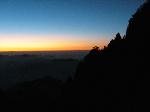
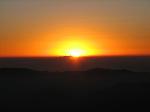
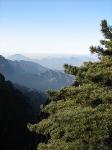

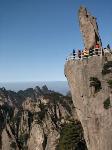
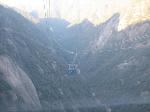

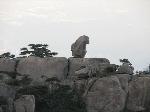

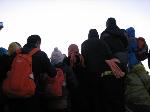
 Copyright © 1998-2025 All rights reserved.
Copyright © 1998-2025 All rights reserved.
1.
May 2, 2008 21:54 Reply
XIAOTIQIN said:
wow-great review. u go girl! I have been to Huangshan twice and would like to go at least 2 more times to catch each season. I saw it during winter and late spring before. Maybe skip summer - too hot.